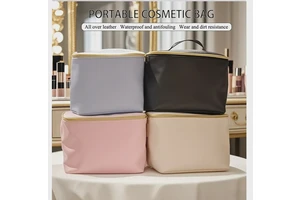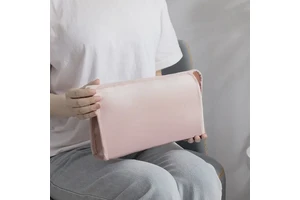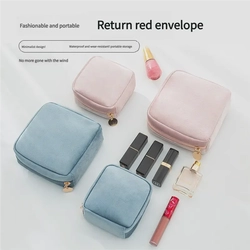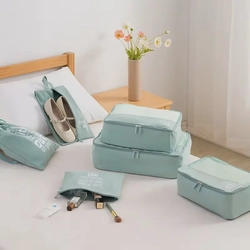How to Clean and Maintain Your Cosmetic Bag for Longevity and Hygiene?
In the realm of beauty, we meticulously care for our skin, our makeup brushes, and even our cosmetic products. Yet, one essential item often gets overlooked in our cleaning routines: the cosmetic bag itself. This seemingly innocuous accessory, which houses our most intimate beauty tools and potions, can quickly become a breeding ground for bacteria, mold, and accumulated grime. A neglected cosmetic bag not only poses a threat to your hygiene and skin health but can also shorten the lifespan of your beloved beauty organizer. This comprehensive guide will delve into the hidden dangers lurking within your cosmetic bag, provide tailored cleaning methods for various materials, offer crucial tips for maintaining the hygiene of your makeup products, and reveal secrets to extending the longevity of your cosmetic bag. Get ready to transform your beauty routine with a clean, healthy, and long-lasting cosmetic companion.
The Hidden Truth: Why Your Cosmetic Bag Might Be Dirtier Than You Think
It's easy to assume that because your cosmetic bag holds clean products, it remains clean itself. However, the reality is often far from it. Every time you reach for a product, a tiny amount of residue, skin cells, or environmental dust can transfer to the bag's interior. Over time, these seemingly insignificant deposits accumulate, creating a complex ecosystem of unseen contaminants.
Understanding the Unseen Enemies: Bacteria, Mold, and Product Residue
Your cosmetic bag is a dark, often warm, and sometimes damp environment – an ideal breeding ground for microorganisms. Studies have shown that cosmetic bags can harbor a surprising array of harmful microbes:
•Bacteria: Common culprits include Staphylococcus (which can cause skin infections), E. coli (often linked to fecal contamination), and Streptococcus. These bacteria can transfer from your hands, uncleaned products, or even the environment, thriving on makeup residue and moisture.
•Mold: If your bag is exposed to dampness (e.g., from a leaky product, a wet brush, or high humidity in a bathroom), mold can quickly develop. Mold spores can trigger allergic reactions, respiratory issues, and contaminate your makeup products.
•Product Residue: Spilled powders, leaky liquids, and smudged creams create a nutrient-rich environment for these microorganisms to flourish. This residue also makes the bag sticky, attracting more dirt and dust.
The Health Risks Associated with a Dirty Makeup Bag (Skin Irritation, Infections)
Using a contaminated cosmetic bag can have direct negative impacts on your skin health and overall well-being:
•Skin Irritation and Breakouts: Bacteria from your bag can transfer to your makeup brushes and then directly onto your face, leading to clogged pores, acne breakouts, and general skin irritation.
•Eye Infections: Contaminated eyeliners, mascaras, or eyeshadows stored in a dirty bag can introduce bacteria to your eyes, potentially causing conjunctivitis (pink eye), styes, or other serious eye infections.
•Other Infections: In more severe cases, harmful bacteria like E. coli can lead to more serious infections if they come into contact with open wounds or mucous membranes.
Common Contaminants: Spilled Powders, Leaky Liquids, and Environmental Dust
Beyond microbial threats, your cosmetic bag is constantly exposed to various forms of physical contamination:
•Spilled Powders: Loose powders, eyeshadows, and blushes can easily spill and settle into the fabric or crevices of your bag, creating a dusty, messy interior.
•Leaky Liquids: Foundation, concealer, liquid lipstick, and skincare products can leak due to loose caps, faulty pumps, or changes in air pressure (especially during travel), leading to sticky, stained interiors.
•Environmental Dust and Debris: Your bag picks up dust, lint, hair, and other debris from your handbag, vanity, or travel environments, adding to the overall uncleanliness.
The Essential Purge: Preparing Your Bag for a Deep Clean
Before you even think about soap and water, the first crucial step in cleaning your cosmetic bag is a thorough purge. This initial phase is vital for removing accumulated debris, identifying items that need to be discarded, and setting the stage for an effective deep clean.
Emptying and Decluttering: Removing Old or Expired Products
Begin by completely emptying your cosmetic bag. Take out every single item – makeup products, brushes, tools, and any miscellaneous bits that have found their way inside. As you remove each item, take a moment to assess it:
•Check Expiration Dates: Many cosmetic products have a PAO (Period After Opening) symbol, a small open jar icon with a number followed by an 'M' (e.g., 6M, 12M). This indicates how many months the product is good for after opening. Discard any products that have passed their PAO or show signs of spoilage (changes in color, texture, or smell).
•Assess Usage: If you haven't used a product in over a year, or if it no longer suits your needs, it's likely time to let it go. Clutter in your cosmetic bag can make it harder to find what you need and can contribute to a less hygienic environment.
•Identify Spills and Leaks: Note any products that have leaked or spilled. These will need extra attention during cleaning, and you might consider transferring them to more secure containers or discarding them if they are beyond salvage.
Disposing of Damaged or Contaminated Items Safely
Proper disposal of expired or contaminated cosmetics is important for both hygiene and environmental reasons:
•Makeup Products: Most makeup products can be disposed of in regular household waste. However, for aerosol cans (like hairspray or dry shampoo), check local regulations for proper disposal, as they may be considered hazardous waste.
•Brushes and Sponges: If brushes are beyond cleaning (e.g., heavily stained with mold or irreparable damage), discard them. Sponges, especially beauty blenders, should be replaced regularly (every 3 months or so) as they are porous and can harbor bacteria.
•Packaging: Recycle empty and clean plastic, glass, or metal packaging according to your local recycling guidelines. Ensure any product residue is thoroughly removed before recycling.
Initial Shake-Out: Removing Loose Debris and Crumbs
Once the bag is empty, turn it inside out over a trash can and give it a good shake. This will dislodge any loose powders, crumbs, dust, hair, and other debris that have settled in the corners and seams. You might be surprised by how much accumulates! For stubborn bits, a small, soft-bristled brush (like an old toothbrush or a clean, dry makeup brush) can help dislodge particles from crevices. A lint roller can also be effective for picking up hair and fine dust from fabric linings. This step is crucial as it removes the bulk of the dry contaminants, making the subsequent wet cleaning process much more effective.
Material Matters: Tailored Cleaning Methods for Every Cosmetic Bag Fabric
The most effective way to clean your cosmetic bag largely depends on the material it's made from. Using the wrong cleaning method can damage the fabric, compromise its integrity, or leave it looking worse than before. Here’s a breakdown of how to clean different types of cosmetic bag materials safely and effectively.
Fabric Bags (Canvas, Nylon, Polyester): Hand Washing vs. Machine Washing, Spot Cleaning, and Drying Tips
Fabric cosmetic bags are common due to their versatility and often stylish designs. Their cleaning method depends on their construction and any delicate embellishments.
•Hand Washing (Recommended for most fabric bags):
1. Prepare a Cleaning Solution: Fill a basin with lukewarm water and add a small amount of mild detergent, such as gentle laundry soap, dish soap, or even baby shampoo. Avoid harsh chemicals or bleach, which can damage colors and fibers.
2. Submerge and Scrub: Submerge the bag in the soapy water. For stubborn stains, use a soft brush (like an old toothbrush or a clean sponge) to gently scrub the affected areas. Pay extra attention to corners and seams where residue tends to accumulate.
3. Rinse Thoroughly: Rinse the bag under cool, running water until all soap residue is gone. Squeeze gently to remove excess water, but avoid wringing, which can distort the bag's shape.
4. Air Dry: Reshape the bag and hang it to air dry. For faster drying and to maintain shape, you can stuff it lightly with clean paper towels or a dry cloth. Ensure it is completely dry before storing or refilling to prevent mold and mildew. Avoid direct sunlight or high heat, which can cause fading or damage.
•Machine Washing (Check care label first): Some durable fabric bags, especially those without rigid structures or delicate embellishments, might be machine washable. Always check the care label. If machine washable:
1. Use a Mesh Laundry Bag: Place the cosmetic bag inside a mesh laundry bag to protect it from snagging or damage during the wash cycle.
2. Gentle Cycle and Cold Water: Use a gentle cycle with cold water and a mild detergent.
3. Air Dry: Always air dry as described above; never put a cosmetic bag in a dryer, as high heat can cause shrinkage, damage materials, or melt internal linings.
•Spot Cleaning: For minor spills or stains, spot cleaning is an excellent option. Dampen a clean cloth with water and a tiny amount of mild soap. Gently blot and rub the stained area until clean. Rinse the cloth and wipe away any soap residue. Air dry the spot completely.
Plastic/Vinyl/TPU Bags (Clear Bags): Simple Wipe-Down Methods, Recommended Cleaning Solutions, and Avoiding Harsh Chemicals
Clear cosmetic bags are popular for their visibility and often waterproof properties. They are generally the easiest to clean.
•Wipe-Down Method:
1. Prepare a Solution: Mix a small amount of mild dish soap with lukewarm water. Alternatively, a diluted solution of rubbing alcohol (70% isopropyl alcohol mixed with equal parts water) can be used for disinfection.
2. Wipe Clean: Dampen a soft cloth or sponge with the cleaning solution and wipe down both the interior and exterior surfaces of the bag. For stubborn makeup stains, a cotton swab dipped in rubbing alcohol or micellar water can be effective.
3. Rinse and Dry: Wipe the bag again with a clean, damp cloth to remove any soap residue. Then, dry thoroughly with a clean, dry cloth or paper towel. Ensure no moisture is left behind, especially in crevices.
•Avoiding Harsh Chemicals: Do not use abrasive cleaners, bleach, or strong solvents on plastic, vinyl, or TPU bags, as these can cause clouding, discoloration, or degrade the material over time.
Leather/Faux Leather Bags: Gentle Cleaning Agents, Conditioning for Longevity, and Avoiding Water Damage
Leather and faux leather bags require a more delicate approach to prevent cracking, drying, or staining.
•Gentle Cleaning:
1. Wipe with a Damp Cloth: For light dirt, simply wipe the bag with a soft, slightly damp cloth. For more stubborn marks, use a specialized leather cleaner or a very mild soap solution (e.g., a drop of baby shampoo in water). Apply the cleaner to a cloth first, not directly to the bag.
2. Wipe Away Residue: Use a clean, damp cloth to wipe off any soap residue.
3. Dry Immediately: Pat the bag dry with a soft, clean towel. Do not air-dry leather, as it can cause cracking.
•Conditioning (for real leather): After cleaning, apply a small amount of leather conditioner to keep the material supple and prevent it from drying out and cracking. Follow the product instructions carefully.
•Avoiding Water Damage: Leather is particularly susceptible to water damage. If your leather bag gets wet, blot it immediately with a dry cloth and let it air dry naturally away from direct heat. Never submerge a leather bag in water.
Specialty Materials (e.g., Silicone, Mesh): Specific Care Instructions for Unique Bag Types
•Silicone Bags: These are highly durable and easy to clean. Simply wash with soap and water, or even put them in the dishwasher (check manufacturer instructions). They are naturally waterproof and quick-drying.
•Mesh Bags: Often made of polyester or nylon mesh, these can usually be hand-washed with mild soap and water. Due to their open weave, they dry very quickly. Ensure all product residue is removed from the mesh holes.
Beyond the Bag: Maintaining Hygiene for Your Makeup Products and Tools
Cleaning your cosmetic bag is only half the battle. For true hygiene and to prevent cross-contamination, it’s equally important to maintain the cleanliness of the items you store inside it – your makeup products and tools.
Regularly Cleaning Makeup Brushes and Sponges
Makeup brushes and sponges are direct contact points with your skin and products, making them prime candidates for bacterial buildup. Regular cleaning is non-negotiable:
•Brushes: Clean makeup brushes at least once a week, or more frequently for brushes used with liquid products (like foundation or concealer). Use a gentle brush, cleanser, or mild soap and lukewarm water. Swirl the bristles on a textured mat or in the palm of your hand until the water runs clear. Reshape the bristles and lay them flat or hang them upside down to dry completely.
•Sponges: Beauty sponges should be cleaned after every use, or at least every few uses, as their porous nature makes them highly susceptible to bacterial growth. Use a solid or liquid sponge cleanser, working it into the damp sponge until all makeup residue is removed. Rinse thoroughly and allow to air dry completely before storing.
Wiping Down Product Packaging (Compacts, Tubes, Bottles)
Even if your products don’t directly touch your skin, their packaging can accumulate dirt, dust, and bacteria from your hands or the environment. A quick wipe-down can make a big difference:
•Compacts and Palettes: Use an alcohol wipe or a cotton pad dampened with rubbing alcohol to clean the exterior of powder compacts, eyeshadow palettes, and blush cases. This disinfects the surface and removes fingerprints and makeup smudges.
•Tubes and Bottles: Wipe down the necks and caps of liquid foundation, concealer, and skincare bottles. Pay attention to areas where the product might accumulate, as this can become sticky and attract more dirt.
•Lipsticks and Lip Glosses: Gently wipe the outside of lipstick tubes and lip gloss wands. For lipsticks, you can also lightly spray the bullet with rubbing alcohol and wipe it clean to sanitize the surface.
Storing Products Properly to Prevent Cross-Contamination
How you store your products within your bag also impacts overall hygiene:
•Separate Tools: Store clean brushes and sponges in a separate, breathable pouch or compartment within your cosmetic bag. Avoid tossing them loosely with other products.
•Secure Lids: Always ensure all product lids, caps, and pumps are tightly closed before placing them in your bag. This prevents leaks and exposure to air and contaminants.
•Individual Pouches: For highly valued or frequently used items, consider using smaller, individual pouches within your main cosmetic bag. This adds an extra layer of protection and organization.
Longevity Secrets: Tips for Extending the Life of Your Cosmetic Bag
Beyond cleaning, proper maintenance and mindful usage can significantly extend the life of your cosmetic bag, ensuring it remains a functional and attractive accessory for years to come.
Proper Storage: Keeping Bags in Cool, Dry Places
Where and how you store your cosmetic bag when not in use plays a crucial role in its longevity:
•Avoid Humidity: Do not store your cosmetic bag in damp environments like steamy bathrooms or humid closets. Excessive moisture can lead to mold, mildew, and material degradation.
•Cool and Dry: Opt for cool, dry, and well-ventilated spaces. A drawer, a shelf in your closet, or a vanity cabinet are ideal.
•Away from Direct Sunlight: Prolonged exposure to direct sunlight can cause colors to fade, and certain materials (especially plastics and faux leather) to become brittle or discolored.
Avoiding Overpacking and Excessive Strain on Zippers and Seams
While it’s tempting to cram as much as possible into your cosmetic bag, overpacking can lead to premature wear and tear:
•Respect Capacity: Every bag has a designed capacity. Overfilling it puts undue stress on zippers, seams, and the material itself, leading to stretching, tearing, or broken closures.
•Even Distribution: Try to distribute the weight and bulk of your products evenly within the bag to prevent bulging in one area, which can strain seams.
Using Protective Inserts or Smaller Pouches for Leaky Items
Prevention is key to avoiding internal damage and extending your bag’s life:
•Leak-Proof Containers: For liquid products that are prone to leaking (e.g., shampoo, liquid foundation), transfer them into smaller, leak-proof travel containers before placing them in your cosmetic bag.
•Secondary Pouches: Use smaller, sealable pouches (ideally waterproof ones) within your main cosmetic bag for items that might leak or spill. This acts as a double barrier, containing any mess and protecting the main bag’s interior.
Regular Maintenance Schedule: How Often to Clean and Inspect Your Bag
Consistency is vital for both hygiene and longevity:
•Weekly Wipe-Down: For bags in daily use, a quick weekly wipe-down of the interior and exterior with a damp cloth or antibacterial wipe can prevent buildup.
•Monthly Deep Clean: Aim for a thorough deep clean every month, especially for bags that see heavy use or carry liquid products. This allows for a more detailed cleaning of all compartments and materials.
•Seasonal Inspection: At least once a season, empty your bag, inspect it for any signs of wear, tear, or damage, and perform a comprehensive deep clean. This is also a good time to reassess your product collection.
By integrating these cleaning and maintenance practices into your beauty routine, your cosmetic bag will not only remain a hygienic sanctuary for your products but also serve you reliably for a much longer time, proving to be a worthwhile investment in your beauty journey.
Frequently Asked Questions (FAQ) and Answers:
Q1: How often should I clean my cosmetic bag?
A1: For daily use bags, a quick wipe-down is recommended weekly, and a deep clean every 1-3 months, depending on usage and material. If you notice spills or visible dirt, clean it immediately.
Q2: Can I put my cosmetic bag in the washing machine?
A2: It depends on the material. Fabric bags (like canvas or nylon) might be machine washable on a gentle cycle with cold water, but always check the care label first. Leather, faux leather, and plastic/vinyl bags should generally be hand-wiped to avoid damage.
Q3: What cleaning products are safe to use on my cosmetic bag?
A3: Mild soap (like dish soap or gentle hand soap) mixed with water is usually safe for most materials. For tougher stains, rubbing alcohol or a specialized fabric cleaner might be used, but always test on an inconspicuous area first. Avoid harsh chemicals or bleach.
Q4: How can I prevent mold and bacteria from growing in my makeup bag?
A4: Regular cleaning is key. Ensure your bag is completely dry before storing it. Avoid putting damp items (like wet brushes) directly into the bag. Store your bag in a cool, dry place, and consider using breathable inserts if humidity is a concern.
Q5: My cosmetic bag has a strong makeup smell. How can I get rid of it?
A5: After cleaning, ensure the bag is thoroughly aired out. You can place an open container of baking soda inside the empty bag for a few days to absorb odors. For persistent smells, a fabric refresher spray designed for odors might help, but avoid spraying directly onto sensitive materials.
Dofollow:
Victoria Green Blog: https://www.victoriagreen.com/blogs/news/how-to-deep-clean-makeup-bag
Miss MonMon: https://missmonmon.com/2023/08/28/how-to-wash-your-makeup-bag/
Get The Gloss: https://www.getthegloss.com/beauty/makeup/how-clean-is-your-makeup-bag/
Truffle: https://truffleco.com/blogs/blog/how-to-clean-makeup-bags





